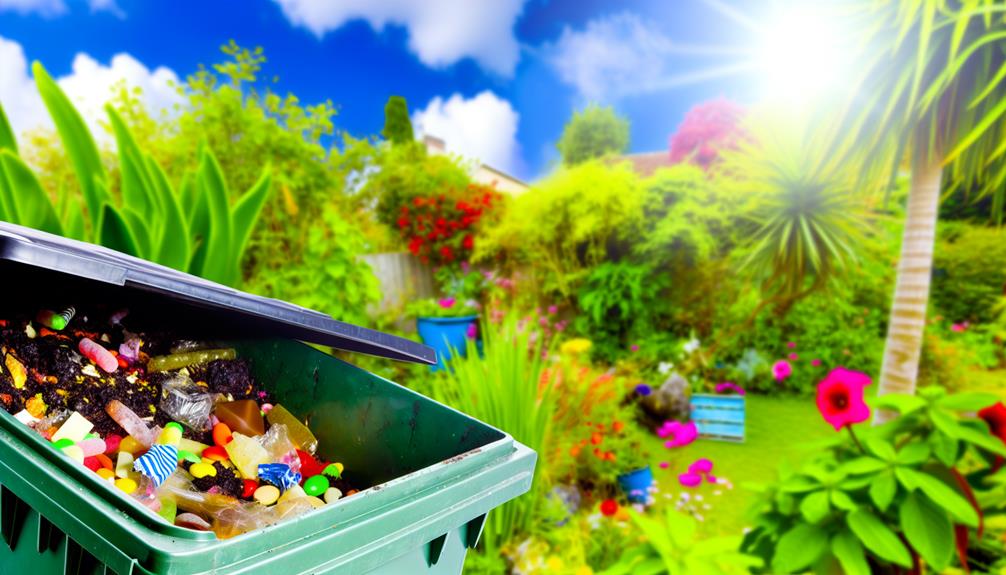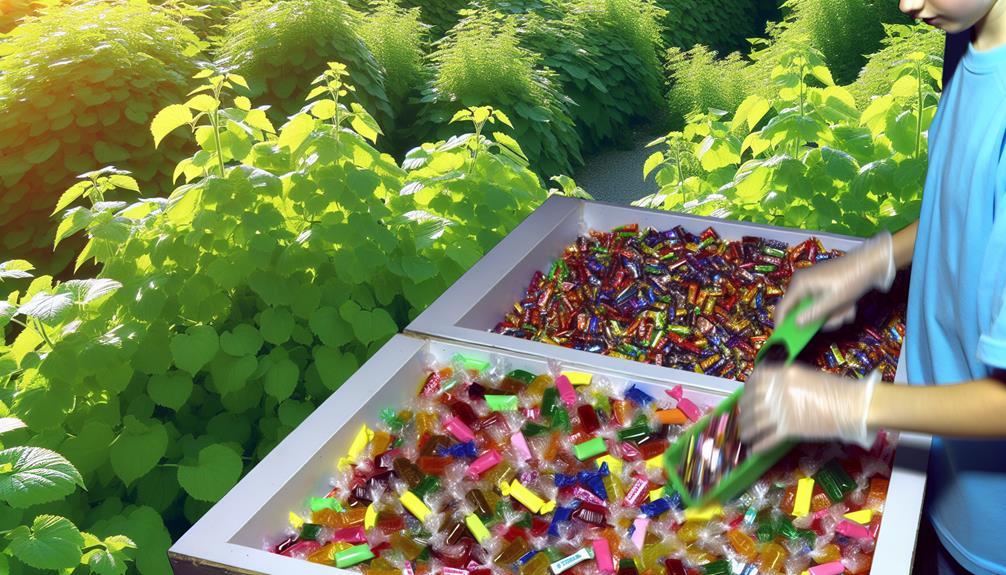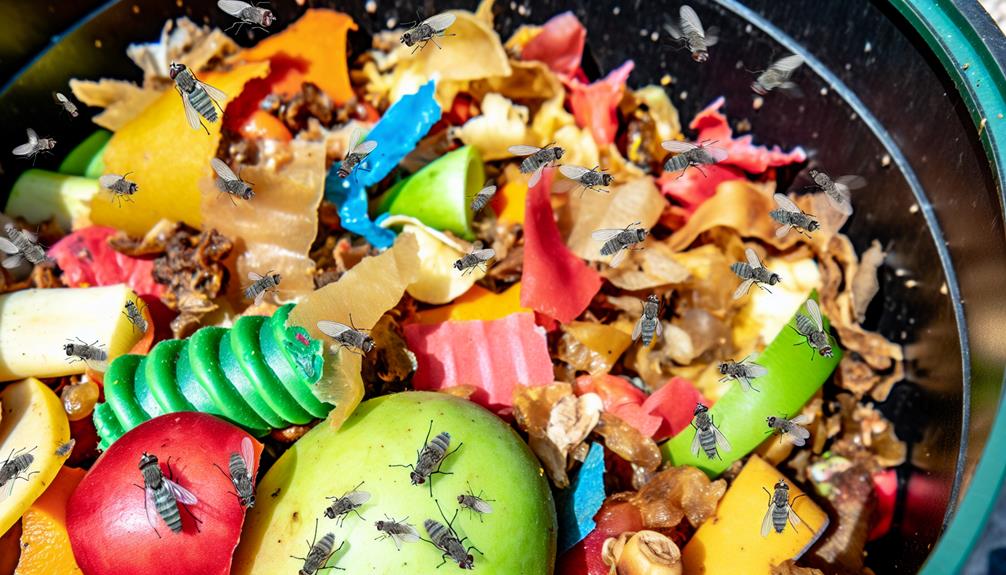

You can definitely compost candy, and it’s a fun way to reduce waste! Focus on hard candies, chocolate chunks, gummy candies, and candy canes. Remember to crush larger candies to speed up decomposition. Always remove non-biodegradable wrappers first. Compost candy in moderation, mixing it with other organic materials like leaves and food scraps.
This balance prevents pests and odors, ensuring a healthy compost pile. Pay attention to moisture levels and turn the pile regularly. Composting candy adds valuable nutrients and attracts beneficial microorganisms to your soil. Ready to transform your candy waste into garden gold? Let’s explore the process!
When composting candy, it’s important to know which types are suitable for your compost pile. Hard candies and candy canes can be composted if you crush them into smaller pieces first.
Chocolate and candy bars are also great, but break them down into chunks before adding them to your food waste.
Gummy candies and fruit snacks are compostable, but only in moderation because of their high sugar content.
Always remove non-biodegradable wrappers like plastic or foil, as they won’t break down.
Mixing candy with other organic materials helps keep your compost pile balanced and healthy.
Embrace these guidelines, and you’ll join a community of eco-conscious individuals committed to reducing food waste and nurturing their compost piles.
Breaking down larger candies into smaller pieces is crucial for efficient composting and faster decomposition. When you break down candies like candy bars into manageable chunks, you guarantee they decompose more quickly.
Crushing hard candies or candy canes with a hammer is a great method to accelerate the process. If you have access to a compost shredder, use it for breaking down these larger pieces into even smaller chunks. This helps your compost pile work more effectively and reduces the overall decomposition time.
Properly breaking down larger candies can greatly enhance your composting efforts, making your pile healthier and more productive. Join your fellow compost enthusiasts in creating nutrient-rich compost by tackling those big candies head-on!
Also Read: Can You Compost Baking Soda?
After breaking down larger candies, it’s important to make sure that non-biodegradable wrappers are removed to maintain a healthy compost pile.

Candy wrappers made of plastic, foil, cellophane, and wax paper with plastic coatings can’t decompose and will hinder the composting process.
To keep your compost bin in top shape, always separate biodegradable candy from its synthetic wrappers.
Removing these non-compostable materials ensures your compost stays pure and effective.
By taking this step, you’ll contribute to a cleaner, greener environment and create high-quality compost.
Your compost bin will thrive without the interference of harmful plastic wrappers, and you’ll feel proud knowing you’re doing your part for the planet.
When composting candy, it’s important to do so in moderation to maintain a balanced compost pile. Too much sugar can disrupt the decomposition process, so mix candy with plenty of organic materials like leaves and food scraps.
Don’t forget to dispose of non-biodegradable wrappers properly to keep your compost healthy and efficient.
To maintain a healthy compost pile, it’s crucial to add candy in moderation and mix it thoroughly with other organic materials. When composting candy, balance it with food scraps and leaves to avoid upsetting the carbon-to-nitrogen ratio.
Here’s a quick guide to help you:
Properly disposing of candy wrappers is crucial to prevent contamination in your compost pile. When dealing with wrappers and packaging, remember that materials like plastic, foil, cellophane, and wax paper with plastic coating are non-biodegradable and should be discarded separately.
However, candy can be composted in moderation. Mixing it with organic materials like leaves and food scraps helps maintain a balanced compost pile. Use a moisture meter to guarantee proper moisture levels and prevent imbalances.
Here’s a quick reference for disposing of candy wrappers:
| Wrapper Type | Compostable | Disposal Method |
|---|---|---|
| Plastic | No | Trash |
| Foil | No | Recycling Bin |
| Cellophane | No | Trash |
| Wax Paper (Plastic) | No | Trash |
Also Read: Can You Compost Bag?
A common challenge in composting candy is dealing with non-biodegradable materials like plastic and foil wrappers. To reduce waste effectively, it’s important to remove these materials before adding candy to your compost.

Another issue is the size of the candy pieces; breaking them into smaller pieces speeds up decomposition.
Here are some common composting challenges:
Also Read: Can You Compost Animal Bedding?
To guarantee your candy composting is a success, maintain the right moisture balance in your pile.
Include a variety of organic materials to create a rich, nutrient-filled compost.
Regularly check the temperature of your compost to make sure it’s decomposing efficiently.
Ensuring your compost has the right moisture level, around 50%, is key to promoting efficient decomposition and healthy microbial activity. This is essential when you’re composting candy to make sure it breaks down properly. To maintain that balance, think of the texture of a wrung-out sponge—neither too wet nor too dry.
Here are some tips to help:
Working together, we can make our composting efforts successful and sustainable!
Incorporating a variety of organic materials into your compost pile is crucial for creating rich, fertile compost and maintaining a healthy balance of nutrients. Adding food scraps, leaves, grass clippings, and coffee grounds guarantees a well-rounded mix that benefits your garden.
Did you know that some decorations can be composted too? Items like straw wreaths and natural garlands contribute to the diversity of your pile. A mix of different materials helps maintain proper airflow and moisture levels, creating an ideal environment for microorganisms to thrive.
This not only accelerates the composting process but also reduces waste and promotes sustainable gardening practices. So, don’t hesitate to toss in those food scraps and natural decorations to enrich your compost and garden.
Regularly monitoring your compost pile’s temperature is key to guaranteeing a healthy and efficient decomposition process. Checking the temperature helps you see if your food waste is breaking down properly. Use a compost thermometer to get accurate readings at different depths in the pile.
Here’s a quick guide:
Keeping your pile at the right temperature fosters a sense of community and shared success in sustainable living!
You shouldn’t compost plastic wrappers, meat or dairy products, and diseased plants. These items can cause odors, attract pests, or contaminate your compost. Stick to organic materials for a thriving, healthy compost community.
You can put sugary things in compost, but do it in moderation to avoid attracting pests. Break them down into smaller pieces and remove any non-biodegradable packaging. Keep an eye on compost balance for best results.
Yes, you can compost chocolate. Just remove any non-compostable packaging first. Chocolate adds nutrients like calcium and potassium, benefiting your plants. Remember to balance it with green material to keep your compost pile healthy and thriving.
Yes, you can compost junk food sparingly. Break it into smaller pieces and mix with other organic materials like leaves and food scraps. Avoid non-biodegradable wrappers and monitor moisture levels to keep your compost healthy.
You can totally compost candy! Just break down larger pieces, remove any non-biodegradable wrappers, and remember to compost in moderation.
If you follow these steps, your compost will thrive. Overcoming challenges like pests or odors is doable with proper management.
Composting candy not only reduces waste but also enriches your soil, making it a win-win. So, get excited about turning those sweet treats into nutrient-rich compost for a healthier garden!
